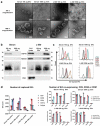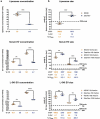Extracellular vesicle measurements with nanoparticle tracking analysis - An accuracy and repeatability comparison between NanoSight NS300 and ZetaView
- PMID: 30988894
- PMCID: PMC6450530
- DOI: 10.1080/20013078.2019.1596016
Extracellular vesicle measurements with nanoparticle tracking analysis - An accuracy and repeatability comparison between NanoSight NS300 and ZetaView
Abstract
The expanding field of extracellular vesicle (EV) research needs reproducible and accurate methods to characterize single EVs. Nanoparticle Tracking Analysis (NTA) is commonly used to determine EV concentration and diameter. As the EV field is lacking methods to easily confirm and validate NTA data, questioning the reliability of measurements remains highly important. In this regard, a comparison addressing measurement quality between different NTA devices such as Malvern's NanoSight NS300 or Particle Metrix' ZetaView has not yet been conducted. To evaluate the accuracy and repeatability of size and concentration determinations of both devices, we employed comparative methods including transmission electron microscopy (TEM) and single particle interferometric reflectance imaging sensing (SP-IRIS) by ExoView. Multiple test measurements with nanospheres, liposomes and ultracentrifuged EVs from human serum and cell culture supernatant were performed. Additionally, serial dilutions and freeze-thaw cycle-dependent EV decrease were measured to determine the robustness of each system. Strikingly, NanoSight NS300 exhibited a 2.0-2.1-fold overestimation of polystyrene and silica nanosphere concentration. By measuring serial dilutions of EV samples, we demonstrated higher accuracy in concentration determination by ZetaView (% BIAS range: 2.7-8.5) in comparison with NanoSight NS300 (% BIAS range: 32.9-36.8). The concentration measurements by ZetaView were also more precise (% CV range: 0.0-4.7) than measurements by NanoSight NS300 (% CV range: 5.4-10.7). On the contrary, quantitative TEM imaging indicated more accurate EV sizing by NanoSight NS300 (% DTEM range: 79.5-134.3) compared to ZetaView (% DTEM range: 111.8-205.7), while being equally repeatable (NanoSight NS300% CV range: 0.8-6.7; ZetaView: 1.4-7.8). However, both devices failed to report a peak EV diameter below 60 nm compared to TEM and SP-IRIS. Taken together, NTA devices differ strongly in their hardware and software affecting measuring results. ZetaView provided a more accurate and repeatable depiction of EV concentration, whereas NanoSight NS300 supplied size measurements of higher resolution.
Keywords: Extracellular vesicles; accuracy; exosomes; nanoparticle tracking analysis; repeatability; reproducibility; single particle interferometric reflectance imaging sensing; transmission electron microscopy.
Figures






Similar articles
-
Comparison of interferometric light microscopy with nanoparticle tracking analysis for the study of extracellular vesicles and bacteriophages.J Extracell Biol. 2023 Feb 23;2(2):e75. doi: 10.1002/jex2.75. eCollection 2023 Feb. J Extracell Biol. 2023. PMID: 38938523 Free PMC article.
-
Differential fluorescence nanoparticle tracking analysis for enumeration of the extracellular vesicle content in mixed particulate solutions.Methods. 2020 May 1;177:67-73. doi: 10.1016/j.ymeth.2020.02.006. Epub 2020 Feb 17. Methods. 2020. PMID: 32081745
-
Flow speed alters the apparent size and concentration of particles measured using NanoSight nanoparticle tracking analysis.Placenta. 2016 Feb;38:29-32. doi: 10.1016/j.placenta.2015.12.004. Epub 2015 Dec 13. Placenta. 2016. PMID: 26907379
-
Overview of extracellular vesicle characterization techniques and introduction to combined reflectance and fluorescence confocal microscopy to distinguish extracellular vesicle subpopulations.Neurophotonics. 2022 Apr;9(2):021903. doi: 10.1117/1.NPh.9.2.021903. Epub 2022 Apr 4. Neurophotonics. 2022. PMID: 35386596 Free PMC article. Review.
-
Analytical challenges of extracellular vesicle detection: A comparison of different techniques.Cytometry A. 2016 Feb;89(2):123-34. doi: 10.1002/cyto.a.22795. Epub 2015 Dec 9. Cytometry A. 2016. PMID: 26651033 Review.
Cited by
-
Nanoscale Extracellular Vesicle-Enabled Liquid Biopsy: Advances and Challenges for Lung Cancer Detection.Micromachines (Basel). 2024 Sep 24;15(10):1181. doi: 10.3390/mi15101181. Micromachines (Basel). 2024. PMID: 39459055 Free PMC article. Review.
-
Beyond the Extracellular Vesicles: Technical Hurdles, Achieved Goals and Current Challenges When Working on Adipose Cells.Int J Mol Sci. 2021 Mar 25;22(7):3362. doi: 10.3390/ijms22073362. Int J Mol Sci. 2021. PMID: 33805982 Free PMC article. Review.
-
Offline Coupling of Asymmetrical Flow Field-Flow Fractionation and Capillary Electrophoresis for Separation of Extracellular Vesicles.Anal Chem. 2022 Oct 18;94(41):14083-14091. doi: 10.1021/acs.analchem.2c03550. Epub 2022 Oct 3. Anal Chem. 2022. PMID: 36191238 Free PMC article.
-
Transcriptomic profiling of cell-free and vesicular microRNAs from matched arterial and venous sera.J Extracell Vesicles. 2019 Sep 27;8(1):1670935. doi: 10.1080/20013078.2019.1670935. eCollection 2019. J Extracell Vesicles. 2019. PMID: 31632620 Free PMC article.
-
Effects of Hypoxia on RNA Cargo in Extracellular Vesicles from Human Adipose-Derived Stromal/Stem Cells.Int J Mol Sci. 2022 Jul 2;23(13):7384. doi: 10.3390/ijms23137384. Int J Mol Sci. 2022. PMID: 35806391 Free PMC article.
References
-
- van Niel G, D’Angelo G, Raposo G.. Shedding light on the cell biology of extracellular vesicles. Nat Rev Mol Cell Biol. 2018;19(4):213–228. PubMed PMID: 29339798. - PubMed
-
- Lotvall J, Hill AF, Hochberg F, et al. Minimal experimental requirements for definition of extracellular vesicles and their functions: a position statement from the international society for extracellular vesicles. J Extracell Vesicles. 2014;3:26913 PubMed PMID: 25536934; PubMed Central PMCID: PMCPMC4275645. eng. - PMC - PubMed
LinkOut - more resources
Full Text Sources
Other Literature Sources
Research Materials

